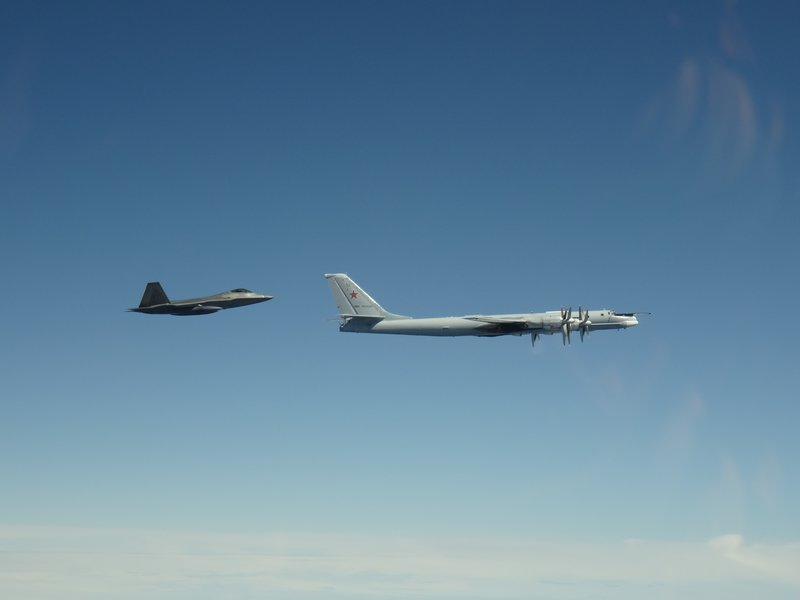
US officials announced on Thursday, Feb. 2, 2023, that they’d scrambled F-22 Raptor interceptors to observe what they believe is a Chinese spy balloon bobbing in the stratosphere over Montana. Composite by Coffee or Die.
US Coast Guard watchstanders have told Coffee or Die that the Chinese balloon that skied across North America is no more.
Downed by the US Air Force on Saturday, Feb. 4, it plummeted tens of thousands of feet to splash into the Atlantic Ocean off the Carolina coast. Its demise arrived mere hours after President Joe Biden got off Air Force One at New York’s Hancock Field Air National Guard base near Syracuse and told a reporter, “We’re gonna take care of it.”
Commercial pilots in North and South Carolina already knew an operation was being prepped because the Federal Aviation Administration paused departures and arrivals to Wilmington, Myrtle Beach International, and Charleston International airports “to support the Department of Defense in a national security effort,” according to an FAA statement.
While the FAA toiled to clear the skies of commercial aviation, the US Coast Guard worked to shoo away any mariners straying into what would become a debris zone once the balloon — roughly the size of three school buses — slapped into the waves.
Although officials said US forces were combing the waters off the Carolinas to retrieve any debris that points to Chinese surveillance efforts before the balloon’s payload sinks, US Navy leaders have yet to say if the fleet is helping the recovery effort.
US Northern Command told Coffee or Die that the Department of Defense would release more information about the balloon busting operation later on Saturday.

Airmen embarked on board the US Navy’s amphibious transport dock Portland prepare to release a weather balloon before the NASA Artemis I Orion capsule recovery, Dec. 11, 2022, off the coast of California. US Navy photo by Mass Communication Specialist 2nd Class Melvin Fatimehin.
NORAD officials announced on Wednesday that they'd been tracking a Chinese spy balloon, adding that the decision had been made to let it fly instead of downing it.
Chinese officials, however, insisted it was just a wayward civilian weather airship blown off course by unexpected gusts.
It swept over Missouri on Friday evening and then pushed off the Carolina coast early Saturday. It previously had slowly soared the Aleutian Islands before moving southeast in the stratosphere, hovering over Montana on Wednesday, Pentagon officials said.
Both North American Aerospace Command and US Northern Command had tracked it the entire time, according to a NORAD statement released late Thursday.
NORAD’s commander, US Air Force Gen. Glen VanHerck, said the large, white orb presented neither a military nor a physical threat to anyone on the ground, and had been scooting along at an altitude higher than the flight paths of commercial airliners.

A US Army Aerostat Persistent Threat Detection System (PTDS) balloon at an undisclosed location in 2012. US Army photo.
Canadian officials added that their forces were tracking what appeared to be at least one more incoming Chinese balloon, and South American forces were monitoring an unmanned airship, too.
“Canada’s intelligence agencies are working with American partners and continue to take all necessary measures to safeguard Canada’s sensitive information from foreign intelligence threats,” read a statement released late Thursday by the Canadian Armed Forces.
But an official statement released by China’s Foreign Ministry on Friday claimed the balloon is a “civilian airship used for research, mainly meteorological purposes,” with “limited self-steering capability,” and had been blown off course by the westerlies.
Beijing chalked the entire incident up to force majeure, a random act that freed China from any responsibility for the errant balloon, but vowed to “continue communicating with the US side and properly handle this unexpected situation.”
Speaking in Mandarin to reporters late Thursday, China’s Ministry of Foreign Affairs spokesperson Mao Ning had urged calm while Beijing’s military forces probed claims of a trespassing balloon.
“China is a responsible country and has always strictly adhered to international laws, and China has no intention to violate the territory and airspace of sovereign countries,” she said.

An F-22 Raptor assigned to Joint Base Elmendorf-Richardson in Alaska intercepts a Russian Tu-95 Bear on June 9, 2020. North American Aerospace Defense command photo.
Montana’s Malmstrom Air Force Base is home to Global Strike Command’s 341st Missile Wing, the airmen who can launch LGM-30 Minuteman III nuclear intercontinental ballistic missiles.
Speculation turned to whether the Chinese were trying to peep inside their missile silos. But Pentagon leaders expressed puzzlement because the bobbing orb isn’t a better surveillance system than China’s existing array of low Earth orbit spy satellites.
But during a hasty press conference organized Thursday evening, Pentagon press secretary Air Force Brig. Gen. Pat Ryder told reporters it’s not the first Chinese balloon to dawdle over the United States, and American forces “acted immediately” this time to protect against its snooping on secret information, although he stopped short of detailing what those counter-balloon measures were.
A powwow of VanHerck, Chairman of the Joint Chiefs of Staff US Army Gen. Mark A. Milley, and Defense Secretary Lloyd Austin, determined it was best to let the intruder amble across the country instead of shooting it down, which might put civilians on the ground in danger of falling debris, even in sparsely populated eastern Montana.

The Century of Progress balloon, flown by US Navy Lt. Cmdr. Thomas G.W. Settle and Marine Corps Maj. C.L Fordney, departed Akron, Ohio, on Nov. 17, 1933, with an intended altitude of 61,237 feet. National Archives & Records Administration photo.
Defense officials told reporters Thursday that they even scrambled F-22 Raptor stealth tactical fighters to intercept and monitor the alleged espionage balloon.
But dithering over the balloon’s fate appeared to end once it ambled offshore.
And now comes a much trickier operation: salvaging the wreckage.
“First you need to know how much damage was done, damage from the missile and the missile’s debris, and then the damage from impact with the water,” said retired US Navy Capt. Lawrence B. Brennan, a maritime law expert who now teaches at Fordham University.

Kite balloons were aerodynamically shaped non-rigid gas bags which carried a basket below for an observer. In the Navy, they were flown off of ships to help detect U-boats. The observer in the basket had a telephone line that ran in the balloon’s tether to the ship below. Painting, oil on wood, by Bruce Ungerland; 1971, now in the collections of US History and Heritage Command.
Brennan suspects that if the payload survived the blast and impact with the sea, it likely sank into relatively shallow waters roughly 12 nautical miles offshore, and rests in mud.
Although the Navy declined comment, Brennan told Coffee or Die that the fleet and Military Sealift Command have the tugs, barges, dive teams, and submersibles necessary to snoop the sand for the payload and then bring it to the surface for analysis.
But it’s also winter, and the seas can get rough.
“I think we’ll be lucky if it’s less than four days to a week,” he said. “But that depends on whether the tug and tug-type vessels are fully manned and the weather is favorable.”
Editor’s note: This is a breaking story and Coffee or Die will continue to update it as more information becomes available.
Read Next: Romeos, Red Sparrows, and the Art of the ‘Honey Trap’

Carl Prine is a former senior editor at Coffee or Die Magazine. He has worked at Navy Times, The San Diego Union-Tribune, and Pittsburgh Tribune-Review. He served in the Marine Corps and the Pennsylvania Army National Guard. His awards include the Joseph Galloway Award for Distinguished Reporting on the military, a first prize from Investigative Reporters & Editors, and the Combat Infantryman Badge.
BRCC and Bad Moon Print Press team up for an exclusive, limited-edition T-shirt design!
BRCC partners with Team Room Design for an exclusive T-shirt release!
Thirty Seconds Out has partnered with BRCC for an exclusive shirt design invoking the God of Winter.
Lucas O'Hara of Grizzly Forge has teamed up with BRCC for a badass, exclusive Shirt Club T-shirt design featuring his most popular knife and tiomahawk.
Coffee or Die sits down with one of the graphic designers behind Black Rifle Coffee's signature look and vibe.
Biden will award the Medal of Honor to a Vietnam War Army helicopter pilot who risked his life to save a reconnaissance team from almost certain death.
Ever wonder how much Jack Mandaville would f*ck sh*t up if he went back in time? The American Revolution didn't even see him coming.
A nearly 200-year-old West Point time capsule that at first appeared to yield little more than dust contains hidden treasure, the US Military Academy said.












